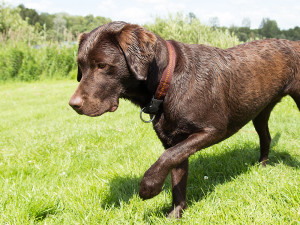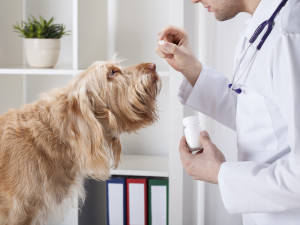A New Study Says Spaying/Neutering Too Early May Health Problems in Certain Dog Breeds
Read on to find out why spaying/neutering is so important, and what the right time is for your pup.

share article
On the list of things to doopens in a new tab when you bring home a new puppy, setting up a spay or neuter surgery isn’t the most exciting — but it’s an important step. Most veterinarians recommend spaying and neutering; the practice helps prevent unwanted litters (which in turn keeps pups out of shelters), mammary gland and testicular cancers, and other behavioral and health problems.
But when it comes to figuring out exactly when your pup needs this surgery, the answer isn’t one-size-fits-all. A new study finds that spaying or neutering a pup too early can cause health problems, and different breeds may want to follow different guidelines.
Before we get into the results of this study, it’s important to state that if you’re adopting a dog from a shelter, the shelter will likely spay or neuter the dog before you can take them home. Many require animals to be fixed before they go home to maintain population control and prevent breeding, which is very importantopens in a new tab. Refer to our expertly written guides for adviceopens in a new tab about spaying and neuteringopens in a new tab.
Spaying and neutering has numerous benefits, including drastically reducing your dog’s chance of getting breast (mammary) cancer, eliminating the risk of testicular cancer in male dogs and reducing prostate cancer risk in male dogs. Dogs who are spayed and neutered can also live up to three years longer opens in a new tabthan those who aren’t.
What this new study says
Veterinarians have known that a dog’s size can affect their spay/neuter surgery risks for some time now. Because larger dogs take longer to reach sexual maturity, it’s usually recommended that they are neutered at a later time than small dogs (around nine to 15 months, as opposed to around six months).
“Spaying or neutering large breeds too soon can lead to a number of health issues later in life, including urinary incontinence, orthopedic issues, and some types of cancer,” Dr. Alycia Washington wrote for us.
In 2020, a previous studyopens in a new tab analyzed 35 dog breeds and found that for certain breeds, being spayed and neutered in the first year of life can increase the risk of developing joint disorders or cancer.
Researchers found that for mixed-breed dogs weighing over 20 kilograms (about 44 pounds) and certain large-breed dogs, there was an increased risk of joint disorders like hip dysplasia, elbow dysplasia, and cranial cruciate ligament tears. Some breeds, including Golden Retrievers (who already have a high cancer riskopens in a new tab), showed an increased risk for some cancers, including lymphosarcoma, mast cell tumors, hemangiosarcoma, and osteosarcoma.
The newest studyopens in a new tab, published in Frontiers in Veterinary Science, added five purebred breeds to the previous study’s list of 35: the German Short/Wirehaired Pointer, Mastiff, Newfoundland, Rhodesian Ridgeback, and Siberian Husky. They found that similar risk discrepancies existed across breeds when pups were spayed or neutered early.
Specifically, male and female Pointer breeds had an elevated risk for joint disorders and cancer, male Mastiff breeds had an increased risk for some joint disorders, female Newfoundland breeds had an increased risk for joint disorders, and female Ridgebacks had an increased risk of mast cell tumors. Some of these risks decreased when dogs were spayed or neutered later in their development.
Editor’s note: The dogs mentioned are all purebreds, who have higher health risksopens in a new tab as a result of their genetics. Shelter pets, who are often mixes, have a lower riskopens in a new tab for these issues.
Bottom line: Your dog should be spayed or neutered
Based on their findings, the researchers created a chart with recommendationsopens in a new tab for the best time for different dog breeds to be spayed or neutered. Australian Cattle Dogs, for example, should be spayed or neutered around six months, according to their recommendation, while male Irish Wolfhounds may want to put off neuter surgeries until very late — about two years of age.
Remember, these results don’t mean that pets shouldn’t be neutered or spayed at all. They do suggest, though, that a more personalized approach to spaying and neutering — rather than one guideline for all dogs — might be useful, again, if you are tasked with deciding when to get this surgery. If your head’s swimming, rest assured: Your veterinarian can help you decide exactly what’s right for your pup.
We also want to be clear that our mission at this site is to encourage adoption. As stated earlier, shelters and rescues have policies set in place that require spaying and neutering to prevent unwanted overpopulation and breeding. Our sister site, Adopt a Petopens in a new tab, is a great place to find adoptable pets at wonderful rescues and shelters.
References:

Sio Hornbuckle
Sio Hornbuckle is a writer living in New York City with their cat, Toni Collette.
Related articles
- opens in a new tab
Male vs. Female Dogs: Are There Any Real Differences?
World-renowned behaviorist Patricia McConnell explains.
![French bulldog puppy looking scared at vet]() opens in a new tab
opens in a new tab10 Things to Ask at Your First Vet Visit
There are no stupid questions — well, when it comes to your dog’s health.
![woman with new puppy]() opens in a new tab
opens in a new tab9 Unexpected To-Dos for New Pet Parents
Sound advice from seasoned dog and cat parents who have been there.
![Closeup of white lab mix dog being pet under the chin by pet parent]() opens in a new tab
opens in a new tabCan Dogs Get Breast Cancer?
Sadly, yes — one in four dogs will develop mammary tumors — but there's an easy way to prevent them.
![Brown Labrador lifting front leg]() opens in a new tab
opens in a new tabHow to Get a Head Start on Your Pet’s Health
Spot lumps, limps, and lethargy early on.
![A vet holding medicine near a dogs face]() opens in a new tab
opens in a new tabHow to Find a Veterinary Specialist
Just like your doctor would refer to you a specialist for expert care for a complicated issue, your vet may do the same for your dog.






